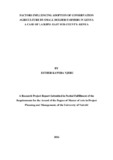| dc.description.abstract | The purpose of this study was to investigate factors influencing adoption of conservation agriculture by small holder farmers in Laikipia East Sub County, in Laikipia County. The study was conducted in three wards of Mukogondo East, Tigithi and Umande. The study was guided by four specific objectives, which were: To determine how demographic factors influences adoption of Conservation Agriculture; assess how land tenure system influences adoption of Conservation Agriculture; determine how household income influences adoption of Conservation Agriculture and to establish how access to credit influences adoption of Conservation Agriculture in Laikipia East Sub County. The study was guided by the Diffusion of Innovation theory and the Adopter Perception model. The research design was a descriptive cross-sectional research design with a sample size of 291 farmers sampled from a target population of 1,200 farmers using the Fisher‟s model of sampling. Stratified random sampling technique was used to select respondents from the three wards. The data collection tools were a structured questionnaire, focus group discussion and key informant interviews. Descriptive statistics (frequencies, percentages) and inferential statistical analysis (correlation and multiple regression) was done, using Statistical Package for Social Sciences Version 21. Qualitative data obtained from the focus group discussions and the key informants was used to complement the quantitative data and was presented in verbatim. The correlation shows that all the variables have a positive relationship with Conservation Agriculture (CA) practice except for education. The results show positive relationships between gender and CA adoption, age, household income, credit access and land tenure. The results showed that age was the most prominent in influencing CA adoption. The results also showed that household income had the most influence on CA adoption followed by access to credit and land tenure system. The study therefore concluded that age, access to credit, land tenure system and household income were factors influencing adoption of CA practices. The study recommends that education and extension training on CA practices should be targeted towards older farmers as majority of the farmers were above 40 years of age. Further training and support for CA adoption to be targeted towards farmers who own their land either through purchase or inheritance and that opportunities for access to credit to be enhanced for CA adoption among households. This could be achieved through financial support by Non-Governmental Organisation‟s (NGOs), private sector, County Government and the National Government. In conclusion, the study was conducted among smallholder farmers in Laikipia East Sub-County only. There is need to conduct further study on other conservation agriculture projects and the effects and impacts of CA adoption among CA adopters in all the 47 counties in the country | en_US |



